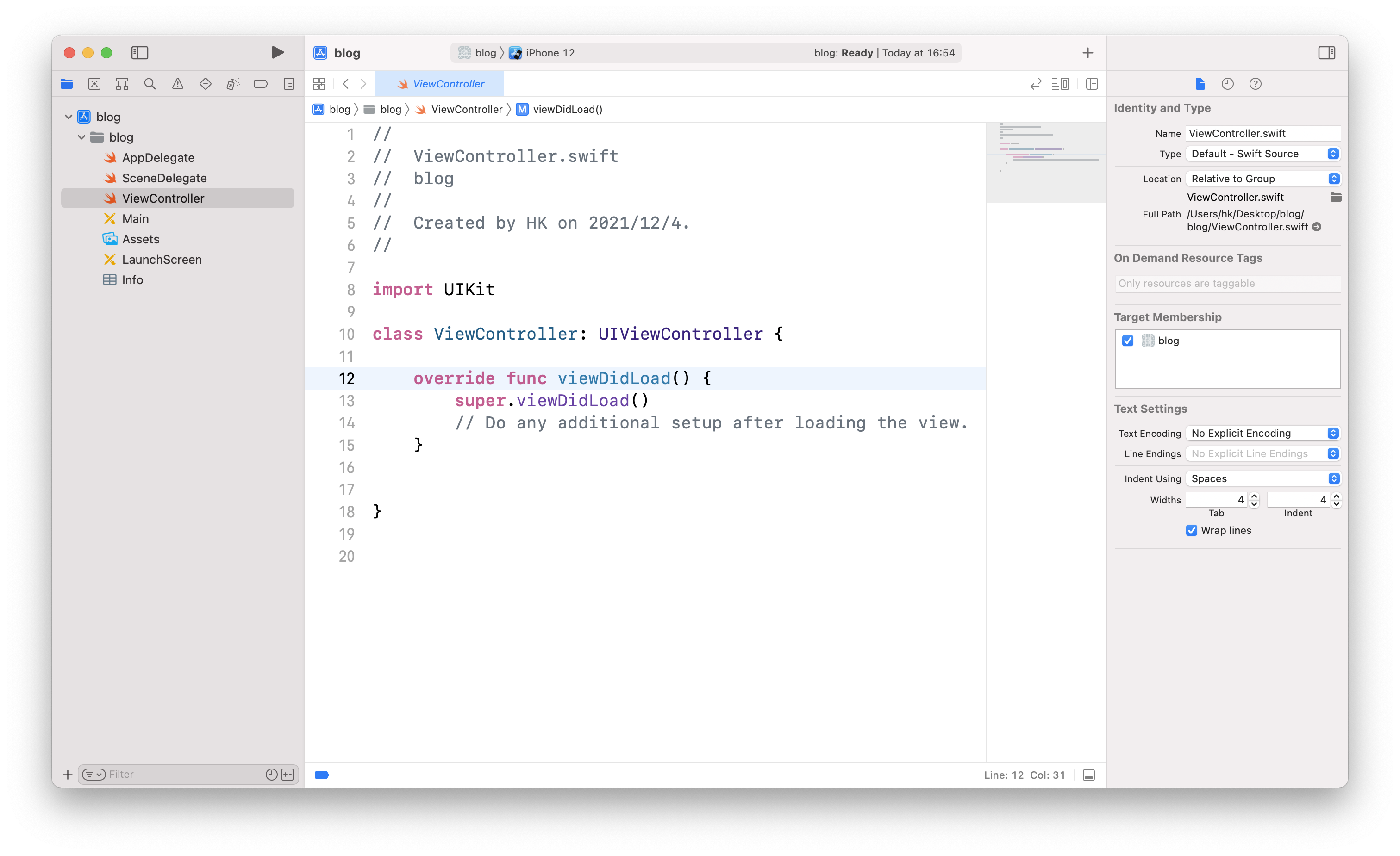本文主要是介绍iOS 开发入门(Storyboard版——Segue跳转与传值、UITableView),希望对大家解决编程问题提供一定的参考价值,需要的开发者们随着小编来一起学习吧!
iOS 开发入门(Storyboard版)
1、项目工程的创建
打开Xcode后点击Create a new Xcode project

选择iOS下的App

Interface选择Storyboard,Language选择Swift

以storyboard方式创建一个项目文件后可以看到如下页面

-
左侧为文件目录
-
中间为工作区,用来写代码或绘制界面
-
右侧为当前页面相关配置
2、以Storyboard方式给页面添加控件
点击左侧的Main文件,进入Storyboard界面,我们将在这里绘制这个App的界面。
首先点击右上角的加号➕,打开控件列表

分别选择一个Label、一个Button、一个TextField(可进行输入的文本框)拖入画布中,并在右侧窗口中对选中的控件进行设置,具体可以进行哪些设置大家可以自己探索一下。

由于接下来我们需要与Textfield和Button进行交互,所以需要在当前页面对应的ViewController中对其进行声明。点击右上角加号➕下的分屏按钮,同时打开Main和ViewController两个页面。将光标移动到对应的控件上,在按住control的同时点住鼠标向代码页拖动。

松开鼠标,建立控件与代码页的链接。将TextField的conncetion设为Outlet(插座变量),Button的connection设为Action(点击事件)。
//给Button绑定点击事件
@IBAction func confirm(_ sender: Any) {//点击Button所要实现的功能
}//将TextField声明为插座变量
@IBOutlet weak var inputTextField: UITextField!
3、添加新页面
在文件目录中新建文件,可以选择以Cocoa Touch Class的方式创建UIViewController,命名为SecondViewController。

回到Main文件,点击右上角加号➕拖入一个新的View Controller页面。选中整个Controller,将右侧的Custom Class中的class设为刚才创建的SecondViewController,以建立代码文件对当前页面的控制。(由于上一个页面是自动创建的,默认与ViewController绑定,所以不需要我们手动设置)

4、Segue页面跳转和传值
(1)页面跳转
按住control的同时把Button向新建的页面拖动,可建立一个Storyboard Segue,设置其标识Identifier为nextPage。

让我们点击左上角的▶︎运行一下这个App,可以看到在点击Button后弹出了一个新页面。
(2)页面传值
在Main文件的第二个页面中添加一个新的Label用于展示传递过来的值,并在SecondViewController中添加如下代码。
import UIKitclass SecondViewController: UIViewController {//viewDidLoad()方法中为当前页面加载时所要执行的操作override func viewDidLoad() {super.viewDidLoad()//把message赋给Label的text以展示messageLabel.text = message}//定义一个变量message用来存放传来的值var message : String?//定义一个插座变量用于展示message@IBOutlet weak var messageLabel: UILabel!
}
在ViewController中添加如下代码。
import UIKitclass ViewController: UIViewController {override func viewDidLoad() {super.viewDidLoad()// Do any additional setup after loading the view.}//segue传值override func prepare(for segue: UIStoryboardSegue, sender: Any?) {//如果当前跳转的标识为"nextPage"if segue.identifier == "nextPage" {//将SecondViewController实例化let secondVC = segue.destination as! SecondViewController//将inputTextField中输入的内容传给SecondViewController中的message变量secondVC.message = inputTextField.text}}@IBOutlet weak var inputTextField: UITextField!
}
重新运行App,在TextField中输入“Hello World”,点击Button后在下一个页面上显示。


5、添加UITableView
在第二个页面中添加一个UITableView,并将其代理delegate和数据源dataSource都设置为当前页面。

在第二个页面的UITableView中添加一个Table View Cell,并新建一个TableViewCell文件用于控制cell。
选中拖入的Table View Cell控件,在右侧框中设置其Custom Class的Class为刚才新建的TableViewCell,设置其标识Identifier为"tableCell"。
在tableVeiwCell中添加一个Label,并在TableViewCell文件中定义这个Label的插座变量cellLabel。

回到SecondViewController文件中,添加以下代码。
import UIKit//使SecondViewController类继承自UITableViewDelegate和UITableViewDataSource,以设置UITableView
class SecondViewController: UIViewController,UITableViewDelegate,UITableViewDataSource {//该方法返回UITableView列表行数(numberOfRowsInSection)func tableView(_ tableView: UITableView, numberOfRowsInSection section: Int) -> Int {//显示3行return 3}//该方法返回UITableView每行所显示的UITableViewCell(ncellForRowAt)func tableView(_ tableView: UITableView, cellForRowAt indexPath: IndexPath) -> UITableViewCell {//将刚才创建的标识为"tableCell"的UITableViewCell实例化let cell = tableView.dequeueReusableCell(withIdentifier: "tableCell", for: indexPath) as! TableViewCell//将message赋给cell中cellLabel的text以展示cell.cellLabel.text = message//返回该cellreturn cell}override func viewDidLoad() {super.viewDidLoad()// Do any additional setup after loading the view.messageLabel.text = message}var message : String?@IBOutlet weak var messageLabel: UILabel!
}
重新运行App,在TextField中输入"Hello World"后点击确定,可以看到跳转到下一页后显示了一个共有三行的UITableView。

在页面中添加一个返回Button,并在SecondViewController中绑定其触发事件。
@IBAction func dismiss(_ sender: Any) {//销毁当前页面,返回上个页面dismiss(animated: true)
}
将第二个页面的显示方式改为Full Screen全屏显示。重新运行App,在第二个页面可通过点击按钮返回上个页面。

这篇关于iOS 开发入门(Storyboard版——Segue跳转与传值、UITableView)的文章就介绍到这儿,希望我们推荐的文章对编程师们有所帮助!







